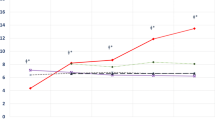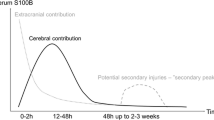Abstract
Purpose
To determine the correlation between serum cleaved tau protein and traumatic mild head injury (MHI) (GCS 13–15).
Methods
A prospective observational study was conducted. Blood specimens from 12 healthy persons and 44 adult patients with traumatic MHI were collected in the emergency department to measure the cleaved tau protein level using a Human Tau phosphoSerine 396 ELISA kit. A brain computed tomography (CT) scan was done in all patients. The serum cleaved tau protein level was considered positive at a cut-off point of 0.1 pg/ml. An intracranial lesion was defined as any abnormality detected by brain CT scan.
Results
The mean age of the traumatic MHI patients was 34.9 ± 15.6 years (range 15–74). The median GCS was 15. The median time from injury to arrival at the emergency department was 30 min. There were 11 intracranial lesions detected by brain CT scan (25.0 %). Serum cleaved tau protein was not detected in either healthy or traumatic MHI patients.
Conclusion
As it was uncorrelated with traumatic MHI, serum cleaved tau protein proved to be an unreliable biomarker to use in the early detection of and decision-making for traumatic MHI patients at the emergency department.
Similar content being viewed by others
References
Shaw GJ, Jauch EC, Zemlan FP. Serum cleave tau protein levels and clinical outcome in adult patients with closed head injury. Ann Emerg Med. 2002;39:254–7.
Li J, Li XY, Feng DF, Pan DC. Biomarkers associated with diffuse traumatic axonal injury: exploring pathogenesis, early diagnosis, and prognosis. J Trauma. 2010;69:1610–8.
Compagnone C, d’Avella D, Servadei F, Angileri FF, Brambilla G, Conti C, et al. Patients with moderate head injury: a prospective multicenter study of 315 patients. Neurosurgery. 2009;64:690–6.
Haydel MJ, Preston CA, Mills TJ, Luber S, Blaudeau E, Deblieux PMC. Indications for computed tomography in patients with minor head injury. N Eng J Med. 2000;343:100–5.
Stiell IG, Wells GA, Vandemheen K, Clement C, Lesiuk H, Laupacis A, et al. The Canadian CT Head Rule for patients with minor head injury. Lancet. 2001;357:1391–6.
Sultan HY, Boyle A, Pereira M, Antoun N, Maimaris C. Application of the Canadian CT head rules in managing minor head injuries in a UK emergency department: implications for the implementation of the NICE guidelines. Emerg Med J. 2004;21:420–5.
Haman SE, Pickering A, Pandor A, Goodacre SW. Clinical decision rules for adults with minor head injury: a systematic review. J Trauma. 2011;71:245–51.
Ingebrigtsen T, Waterloo K, Marup-Jensen S, Attner E, Romner B. Quantification of post-concussion symptoms 3 months after minor head injury in 100 consecutive patients. J Neurol. 1998;245:609–12.
Woertgen C, Rothoerl RD, Metz C, Brawanski A. Comparison of clinical, radiologic, and serum marker as prognostic factors after severe head injury. J Trauma. 1999;47:1126–30.
Jönsson H, Johnsson P, Alling C, Bäckström M, Bergh C, Blomquist S. S100beta after coronary artery surgery: release pattern, source of contamination, and relation to neuropsychological outcome. Ann Thorac Surg. 1999;68:2202–8.
Raabe A, Orolms C, Seifert V. Serum markers of brain damage and outcome predictor in patients after severe head injury. Br J Neurosurg. 1999;13(1):56–9.
Herrmann M, Jost S, Kutz S, Ebert AD, Kratz T, Wunderlich MT, et al. Temporal profile of release of neurobiochemical markers of brain damage after traumatic brain injury is associated with intracranial pathology as demonstrated in cranial computerized head tomography. J Neurotrauma. 2000;17:113–22.
Zemlan FP, Rosenberg WS, Luebbe PA, Campbell TA, Dean GE, Weiner NE, et al. Quantification of axonal damage in traumatic brain injury: affinity purification and characterization of cerebrospinal fluid tau protein. J Neurochem. 1999;72:741–50.
Lang E, Otvos L. A serine → proline change in the Alzheimer’s disease-associated epitope tau 2 results in altered secondary structure, but phosphorylation overcomes the conformational GAP. Biochem Biophys Res Commun. 1992;88(1):162–9.
Gabbita SP, Scheff SW, Menard RM, Roberts K, Fugaccia I, Zemlan FP. Cleaved-tau: a biomarker of neuronal damage after traumatic brain injury. J Neurotrauma. 2005;22:83–94.
Zemlan FP, Jauch EC, Mulchahey JJ, Gabbita SP, Rosenberg WS, Speciale SG, et al. C-tau biomarkers of neuronal damage in severe brain injured patients: association with elevated intracranial pressure and clinical outcome. Brain Res. 2002;947:131–9.
Shiiya N, Kunihara T, Miyatake T, Maysuzaki K, Yasuda K. Tau protein in the cerebrospinal fluid in a marker of brain injury after aortic surgery. Ann Thorac Surg. 2004;77:2034–8.
Liliang PC, Liang CL, Lu K, Wang KW, Weng HC, Hsieh CH, et al. Relationship between injury severity and serum tau protein levels in traumatic brain injured rats. Resuscitation. 2010;81:1205–8.
Ost M, Nylen K, Csajbok L, Ohrfelt AO, Tullberg M, Wikkelso C, et al. Initial CSF total tau correlates with 1-year outcome in patients with traumatic brain injury. Neurology. 2006;67:1600–4.
Bulut M, Koksal O, Dogan S, Bolca N, Ozguc H, Korfali E, et al. Tau protein as a serum marker of brain damage in mild traumatic brain injury: preliminary results. Adv Ther. 2006;23:12–22.
Kavalci C, Pekdemir M, Durukan P, Lihan N, Yildiz M, Serhatlioglu S, et al. The value of serum taum protein for the diagnosis of intracranial injury in minor head trauma. Am J Emerg Med. 2007;25:391–5.
Guzel A, Karasalihoglu S, Aylanc H, Temizoz O, Hicdonmez T. Validity of serum tau protein levels in pediatric patients with minor head trauma. Am J Emerg Med. 2010;28:399–403.
Liliang PC, Liang CL, Weng HC, Lu K, Wang KW, Chen HC, et al. Tau proteins in serum predict outcome after severe traumatic brain injury. J Surg Res. 2010;160:302–7.
Ma M, Lindsell CJ, Rosenberry CM, Shaw GJ, Zemlan FP. Serum cleaved tau does not predict postconcussion syndrome after mild traumatic brain injury. Am J Emerg Med. 2008;26:763–8.
Bazarian JJ, Zemlan FP, Mookerjee S, Stigbrand T. Serum S-100B and cleaved-tau are poor predictors of long-term outcome after mild traumatic brain injury. Brain Inj. 2006;20:759–65.
Begaz T, Kyriacou DN, Segal J, Bazarian JJ. Serum biochemical markers for post-concussion syndrome in patients with mild traumatic brain injury. J Neurotrauma. 2006;23:1201–10.
Acknowledgments
The authors thank the Songklanagarind Hospital data registry for the original data presented in the Introduction, Kingkarn Waiyanak for article searches and retrieval, Glenn K. Shingledecker for his help in editing the manuscript, and the Faculty of Medicine, Prince of Songkla University, for funding this research.
Conflict of interest
The authors declare that they have no conflict of interest.
Author information
Authors and Affiliations
Corresponding author
Rights and permissions
About this article
Cite this article
Wuthisuthimethawee, P., Saeheng, S. & Oearsakul, T. Serum cleaved tau protein and traumatic mild head injury: a preliminary study in the Thai population. Eur J Trauma Emerg Surg 39, 293–296 (2013). https://doi.org/10.1007/s00068-013-0263-9
Received:
Accepted:
Published:
Issue Date:
DOI: https://doi.org/10.1007/s00068-013-0263-9




